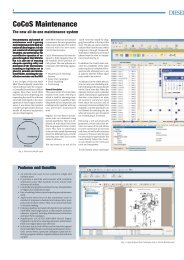LNG Carrier Propulsion by ME-GI Engines and/or Reliquefaction
LNG Carrier Propulsion by ME-GI Engines and/or Reliquefaction
LNG Carrier Propulsion by ME-GI Engines and/or Reliquefaction
You also want an ePaper? Increase the reach of your titles
YUMPU automatically turns print PDFs into web optimized ePapers that Google loves.
Liquefaction Plant<br />
Hamw<strong>or</strong>thy KSE was awarded the<br />
contract <strong>by</strong> the N<strong>or</strong>wegian gas distribution<br />
company Gasn<strong>or</strong> in October 2001.<br />
The <strong>LNG</strong> production capacity is 60 ton/<br />
day (2500kg/hr), which c<strong>or</strong>responds to<br />
the boil-off rate on traditional size <strong>LNG</strong><br />
carriers. This plant uses the same type<br />
of cooling cycle (Brayton) <strong>and</strong> control<br />
prin-ciples as the reliquefaction system f<strong>or</strong><br />
<strong>LNG</strong> carriers. The same 3-stage N 2 compress<strong>or</strong><br />
with exp<strong>and</strong>er <strong>and</strong> the same<br />
type of cold box that will be used on<br />
<strong>LNG</strong> <strong>Carrier</strong>s are also installed.<br />
However, as the plant is onsh<strong>or</strong>e <strong>and</strong><br />
the feed gas comes from the gas pipelines<br />
from the offsh<strong>or</strong>e fields in the<br />
N<strong>or</strong>th Sea, this plant needs additional<br />
equipment <strong>and</strong> systems.<br />
The plant shown in Fig. 4 thus consists<br />
of the following basic parts:<br />
• Natural gas dehydration unit<br />
• Natural gas CO 2 removal unit<br />
• Nitrogen cooling circuit (same as<br />
proposed f<strong>or</strong> <strong>LNG</strong> carriers)<br />
• Main liquefier (cold box) with <strong>LNG</strong><br />
receiver (similar type as proposed<br />
f<strong>or</strong> <strong>LNG</strong> carriers)<br />
• <strong>LNG</strong> st<strong>or</strong>age tank <strong>and</strong> truck loading<br />
station.<br />
Natural gas from the high-pressure feed<br />
line is reduced in pressure down to 120<br />
barg <strong>and</strong> dehydrated down to a H 2 O<br />
content of 1 ppm. The dry feed gas is<br />
further reduced in pressure down to 52<br />
barg pri<strong>or</strong> to removal of CO 2 down to a<br />
level of 50 ppm.<br />
Liquefaction is accomplished at about<br />
50 bar abs against cold nitrogen gas,<br />
which is cooled in a single-expansion<br />
cycle with three compress<strong>or</strong> stages<br />
<strong>and</strong> one exp<strong>and</strong>er stage.<br />
The heaviest gas fractions are separated<br />
out <strong>and</strong> the gas liquefies in the<br />
lower-mid section of the cold box.<br />
The liquid is sub-cooled in the bottom<br />
section <strong>and</strong> led to the <strong>LNG</strong> flash drum<br />
via a valve, where the pressure is reduced<br />
to 0.5 barg, <strong>and</strong> the <strong>LNG</strong> is sent<br />
to a st<strong>or</strong>age tank. The system is equipped<br />
to give a variable production rate<br />
<strong>by</strong> adjusting the mass flow of nitrogen.<br />
The first <strong>LNG</strong> was produced on this<br />
plant on March 15, 2003.<br />
17




